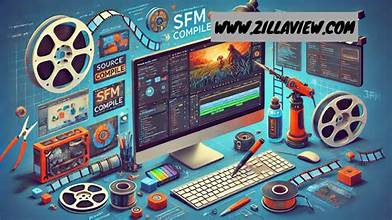Introduction to SFM Compile
When it comes to the world of 3D animation and modeling, Source Filmmaker (SFM) stands out as a powerful tool. It’s often used for creating cinematic animations within the Source engine, the same one used in games like “Team Fortress 2” and “Half-Life 2.” One of the most crucial elements in working with SFM is the “SFM compile” process, which can be confusing for newcomers and even seasoned users.
In this article, we will walk through the process of SFM compile, breaking down its significance, the steps involved, and how you can optimize your workflow to ensure that you can effectively use the compiled assets within SFM.
What is SFM Compile?
The term SFM compile refers to the process of compiling various 3D models, textures, and animations into a format that can be used by the Source engine for rendering within Source Filmmaker. When working with custom models, textures, or animations, these assets must be compiled into a file format that is compatible with SFM. Without the SFM compile process, the assets will not function properly within the Source engine.
The SFM compile process typically involves the conversion of various files into the appropriate formats, including .mdl for models, .vmt for materials, and other Source engine file types. The result is a set of compiled files that can be imported into Source Filmmaker for use in animation and cinematics.
Why is SFM Compile Important?
Compiling is a necessary step in the process of creating custom assets for SFM. Without it, custom models, textures, and animations would not function correctly within the SFM environment. The SFM compile process ensures that assets are in the correct format for Source Filmmaker and that they can be properly utilized for animation purposes.
In addition, the SFM compile process can be used to optimize assets. By compiling models and textures with specific settings, users can control things like level of detail (LOD), collision meshes, and other optimizations that can help improve the performance of the final animation. This makes SFM compile an essential skill for anyone looking to work with custom assets in SFM.
Steps Involved in SFM Compile

There are several steps involved in the SFM compile process. While the specifics may vary depending on the assets you’re working with, the general workflow remains consistent. Here are the primary steps involved:
- Creating the Model or Asset
The first step in the SFM compile process is creating the 3D model or other asset you want to use in SFM. This can be done in various 3D modeling programs such as Blender, 3ds Max, or Maya. These programs allow you to create the geometry, textures, and animations that will make up your model or asset.
- Exporting the Model to the Correct Format
Once the model has been created, it needs to be exported to a format that can be used in the SFM compile process. The most common file formats used for this step are .obj, .fbx, or .smd. These formats contain the geometry and animation data that will be compiled into the final asset.
- Setting Up the QC File
Before you can proceed with the actual SFM compile, you need to create a QC (compile configuration) file. This file is used to define the settings for the compilation process, such as the name of the model, its materials, animations, and other properties. The QC file also defines the paths for the input and output files, ensuring that the compiled files are placed in the correct locations.
- Running the Compile Process
With the QC file set up, the next step is to run the SFM compile process. This is typically done using a command-line tool like Studiomdl, which is part of the Source SDK. When the command is executed, Studiomdl will read the QC file and begin compiling the model, textures, and animations into the appropriate format for use in SFM.
During this process, the tool will convert the model’s geometry into the .mdl format, apply the textures to the model, and process any animations. If there are any errors in the QC file or the model itself, the compile process will fail, and you’ll need to resolve the issues before proceeding.
- Testing the Compiled Model in SFM
Once the SFM compile process is complete, the next step is to test the compiled model in Source Filmmaker. This involves importing the model into your SFM project and checking to ensure that it functions as expected. This includes verifying that the textures are applied correctly, the model’s geometry looks correct, and any animations are working as intended.
If everything looks good, you can continue working with the model within SFM. However, if there are any issues, you may need to return to the modeling or QC file and make adjustments before re-compiling.
Common Issues During the SFM Compile Process
While the SFM compile process is relatively straightforward, there are a few common issues that users often encounter. Below are some of the most frequent problems and potential solutions.
- Missing Textures
One of the most common issues in the SFM compile process is missing textures. This happens when the model’s materials are not correctly referenced in the QC file, or when the texture files are not located in the correct directory. To fix this, double-check that the texture paths in the QC file are accurate and ensure that all necessary texture files are located in the correct directories.
- Model Scaling Issues
Sometimes, models can appear too large or too small in Source Filmmaker after compiling. This can be caused by incorrect scale settings in the 3D modeling program or an error in the QC file. To fix this, ensure that your model’s scale is correct before exporting, and check that the scale settings in the QC file are properly configured.
- Animation Errors
Another common issue occurs when animations do not play correctly after compiling. This can be caused by incorrect animation file paths in the QC file or errors in the animation data itself. To resolve this, check that the animation files are correctly referenced in the QC file and ensure that the animations are properly exported from the 3D modeling software.
- Compile Failures
Compile failures can occur for various reasons, including errors in the QC file, issues with the model’s geometry, or missing dependencies. If the SFM compile process fails, carefully read the error message to identify the cause of the failure. Common solutions include fixing syntax errors in the QC file, ensuring that all required files are present, and troubleshooting model issues like missing bones or corrupted meshes.
Best Practices for Efficient SFM Compile

To streamline the SFM compile process and avoid common pitfalls, here are some best practices you can follow:
- Keep Your File Structure Organized
One of the keys to successful SFM compile is maintaining an organized file structure. Keep all of your assets, including models, textures, and animations, in dedicated folders that are easy to navigate. This will not only help during the compilation process but will also make it easier to troubleshoot any issues that arise.
- Optimize Your Models and Textures
To ensure that your compiled models perform well in SFM, it’s important to optimize both the models and the textures before compiling. This includes reducing polygon counts where possible, simplifying complex geometry, and compressing texture files to reduce file sizes. This will help improve the performance of your animations and cinematics.
- Test Early and Often
Don’t wait until the end of the compile process to test your assets in SFM. Instead, test your models and animations frequently throughout the process to ensure that everything is working correctly. This will allow you to catch any issues early and fix them before they become more complicated to resolve.
- Use External Tools for Troubleshooting
If you run into problems with the SFM compile process, there are several external tools available that can help you troubleshoot. For example, the Source SDK has a variety of diagnostic tools that can help you identify and fix common issues with models and animations.
Also read www.eyexconcom: The Future of Visionary Technologies and Innovation
Conclusion
The SFM compile process is an essential skill for anyone working with custom assets in Source Filmmaker. By understanding the steps involved, common issues, and best practices, you can ensure that your assets are properly compiled and ready for use in your animations and cinematics. Whether you’re creating custom models, textures, or animations, mastering the SFM compile process will help you get the most out of Source Filmmaker and take your 3D animation skills to the next level.
